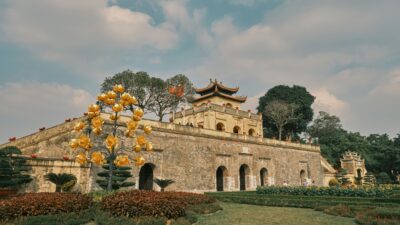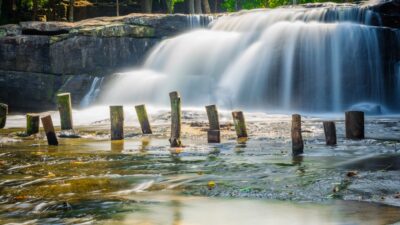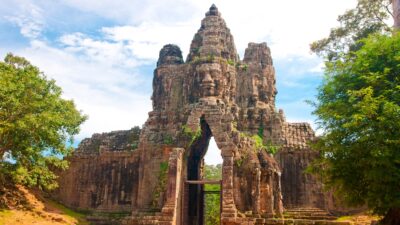Escape the hustle and bustle of everyday life and step into the tranquil beauty of Bich Dong Pagoda, a true hidden gem nestled within the breathtaking karst landscape of Ninh Binh – often referred to as “Ha Long Bay on Land”! Unlike grand, sprawling complexes, Bich Dong Pagoda offers a unique and intimate experience, a serene sanctuary carved into the very mountainside of Ngu Nhac Mountain. This isn’t just another pagoda; it’s a significant cave temple, a place where nature and spirituality intertwine seamlessly, forming part of the Tam Coc-Bich Dong tourist area within the larger Trang An Scenic Landscape Complex. Known for its peaceful atmosphere, stunning traditional Vietnamese architecture that harmonizes with its natural surroundings, and rich historical significance, Bich Dong Pagoda is a must-visit for first-time travelers to Ninh Binh seeking cultural immersion and a moment of quiet contemplation amidst incredible beauty. It stands as a testament to Vietnam’s deep Buddhist traditions.

Preparing for your visit to Bich Dong Pagoda
To make the most of Bich Dong Pagoda, a key highlight among the things to do in Ninh Binh, a little pre-planning will enhance your experience, ensuring a comfortable and meaningful visit. Let’s consider the best timing, suitable duration, and what to wear and bring for this spiritual journey
Best time to visit Bich Dong Pagoda
Choosing the best time to visit Bich Dong Pagoda depends on your preferences regarding climatic conditions and tourist density.
- Spring (February to April) offers pleasant weather and lush greenery, making it a comfortable time to explore both the caves and the outdoor areas.
- Autumn (September to November) provides cool and dry conditions, ideal for walking and climbing the steps within the complex, plus you might catch the golden rice harvest in the nearby Tam Coc area, adding to the scenic charm and photographic opportunities.
- Summer (May to August) can be hot and humid, but the caves themselves offer a cooler respite, and visiting early morning or late afternoon can help you avoid the midday heat.
- Winter (December to January) brings cooler temperatures, sometimes with drizzle, and very few crowds, offering a uniquely misty and atmospheric experience, though it can be a bit gloomy for some.
Weekdays are generally less crowded than weekends at Bich Dong Pagoda. For the most comfortable experience, especially in the warmer months, aim to visit early in the morning (around 7:30 AM – 9:00 AM) or late in the afternoon (around 3:00 PM – 5:00 PM), when temperatures are milder and the light is often softer and more beautiful for photography.
Personally, I find Spring and Autumn to be particularly lovely times to visit Bich Dong Pagoda. Spring’s fresh greenery and pleasant temperatures create a vibrant setting, while Autumn’s golden hues and comfortable weather are perfect for exploring its three-tiered structure at a leisurely pace.
READ MORE: Best time to visit Ninh Binh
How long to spend at Bich Dong Pagoda
To fully appreciate Bich Dong Pagoda, dedicate an adequate amount of time to your visit. A minimum of one to two hours is needed to see the main pagodas and caves at a comfortable pace. However, I recommend allowing two to three hours to fully explore all three pagoda levels – the Lower Pagoda (Ha Pagoda), Middle Pagoda (Trung Pagoda), and Upper Pagoda (Thuong Pagoda) – as well as to take in the views and simply soak in the serene atmosphere. Many visitors combine a trip to Bich Dong Pagoda with a boat tour in nearby Tam Coc, often making it a half-day or full-day excursion. For first-time visitors, allocating two to three hours for Bich Dong itself is a good guideline for a fulfilling experience without feeling rushed, allowing for both exploration and moments of reflection.
What to wear to Bich Dong Pagoda?
While the dress code at Bich Dong Pagoda isn’t as strictly enforced as at some of Vietnam’s grander pagodas, it’s still important to dress respectfully when visiting this religious site to honor its cultural sensitivity. Modest attire is always appreciated. Ideally, opt for clothing that covers your shoulders and knees, especially when you plan to enter the pagoda halls. Comfortable shoes are absolutely essential! You will be navigating steps, uneven surfaces, and potentially slippery cave floors, so sturdy and comfortable footwear is crucial for both safety and enjoyment. Given Vietnam’s generally warm climate, light and breathable clothing is recommended. A hat and sunglasses can be helpful for sun protection when you are walking between the different pagoda levels, which are partially outdoors.
What to bring to Bich Dong Pagoda?
Packing thoughtfully will enhance your visit to Bich Dong Pagoda. Water is a must, especially as you’ll be climbing steps, so bring a bottle to stay hydrated. Comfortable shoes, as mentioned, are paramount. Don’t forget your camera or phone to capture the beauty of the pagoda and its cave setting. For photography inside the caves, a phone with good low-light capabilities or a dedicated camera will be beneficial.
Bringing some Vietnamese Dong (VND) in cash is advisable for potential small entrance fees for specific sections (though general pagoda entry is often free, always best to check current details), for purchasing drinks or snacks if available from vendors outside, for souvenirs, or for making optional donations at the pagoda to support its upkeep. A small backpack is handy to keep your essentials organized and your hands free for climbing and exploring. Insect repellent can be useful, especially as Bich Dong Pagoda is surrounded by lush greenery where mosquitoes might be present.
While not essential, a small flashlight or torch (your phone flashlight often suffices) can be helpful as some areas within the caves, like the Dark Cave (Hang Toi), can be dimly lit, allowing you to appreciate details more easily. And if you prefer wearing socks inside temples where shoes are removed, you might want to bring a pair of socks along.
Transportation options for your journey to Bich Dong Pagoda
Reaching Bich Dong Pagoda is convenient, especially if you are already in the Tam Coc area, renowned for its stunning limestone karst scenery.
From Tam Coc to Bich Dong Pagoda
If you are staying in Tam Coc, the most popular and enjoyable way to reach Bich Dong Pagoda is by bicycle. It’s a short and scenic ride (approx. 2-3 km) from Tam Coc town, passing through beautiful countryside landscapes. Bicycle rentals are widely available in Tam Coc. Motorbikes or scooters are also a quick and convenient option, easily rented in Tam Coc or Ninh Binh City if you prefer motorized transport. Taxis and xe om (motorbike taxis) are readily available in Tam Coc as well, offering a comfortable option if you don’t want to cycle or drive yourself. Remember to negotiate the price beforehand if taking a xe om or taxi. Walking is also theoretically possible if your accommodation is very close to Bich Dong Pagoda, but consider the distance and the heat, especially during midday.
For me, cycling from Tam Coc to Bich Dong Pagoda is always a highlight. The gentle ride through the rice paddies and past local villages is a beautiful prelude to the tranquility of the pagoda itself, set against Ngu Nhac Mountain.
READ MORE: How to get from Hanoi to Ninh Binh
From Ninh Binh City to Bich Dong Pagoda
If you are starting from Ninh Binh City (approx. 10-12 km away), taxis offer the most convenient direct transport to Bich Dong Pagoda. Remember to negotiate the price or ask the driver to use the meter. Motorbike taxis (xe om) are a cheaper alternative to taxis, but less comfortable for longer distances. Renting a motorbike or scooter in Ninh Binh City and driving yourself is also an option, providing freedom to explore the area at your own pace. Local buses might exist, but they are likely less direct and involve transfers, making them less recommended for first-time visitors seeking a straightforward route to Bich Dong Pagoda.
Visiting Bich Dong Pagoda as part of a tour
Many travelers opt to visit Bich Dong Pagoda as part of a larger tour. Day tours from Hanoi often include Bich Dong along with other highlights like Tam Coc, Hoa Lu Ancient Capital, or Trang An Grottoes, offering a convenient way to see multiple attractions in a single day. Similarly, tours starting from Ninh Binh City or Tam Coc frequently include Bich Dong Pagoda in their itineraries. While tours offer convenience and often include a guide providing historical context, they can sometimes feel a bit rushed compared to exploring independently.
Exploring Bich Dong Pagoda: Levels and caves to discover

Exploring Bich Dong Pagoda is a journey through three distinct levels, each offering its own unique charm and spiritual atmosphere, connected by stone steps.
The three main pagodas of Bich Dong Pagoda
Your exploration typically begins at the Lower Pagoda (Ha Pagoda), situated at ground level near the main entrance and often heralded by a picturesque stone bridge over a lotus pond. This pagoda is often your first introduction to Bich Dong’s architectural style, characterized by its blending of traditional Vietnamese pagoda elements (ironwood, stone pillars) with the natural cave setting. As you ascend approximately 100-120 stone steps, you’ll reach the Middle Pagoda (Trung Pagoda), nestled partway up the mountainside.
This pagoda is particularly captivating as it is built directly into a natural cave, creating a unique fusion of man-made structure and natural rock formations. Inside the cave, you’ll find statues, the ancient bronze bell cast in 1707, and a serene atmosphere. Finally, the climb culminates at the Upper Pagoda (Thuong Pagoda), located at the highest point, further up the mountain, often accessed after passing through the Dark Cave and ascending about 40 more steps. Reaching this level requires a bit more effort, but the reward is well worth it. The Upper Pagoda, dedicated to Bodhisattva Avalokitesvara (Guanyin), is also set within a cave and offers not only a sense of spiritual elevation but, most importantly, breathtaking panoramic views of the surrounding Tam Coc landscape, with its iconic rice paddies and karst mountains stretching out before you.
Key features and highlights within Bich Dong Pagoda
Throughout your exploration of Bich Dong Pagoda, pay attention to the key features that make it so special. Statues of Buddha and various Bodhisattvas are present at each level, each with its own significance within Buddhist tradition. The cave setting itself is a major highlight, with natural rock formations becoming part of the temple’s structure. Notice the Vietnamese pagoda architecture, characterized by the use of wood, gracefully curved tiled roofs resembling phoenix tails, and designs that harmonize with the cave environment. The historic bronze bell from 1707 and ancient stone steles inscribed with the pagoda’s history are significant relics.
The courtyards and pathways connecting the different pagoda levels are also worth appreciating, offering peaceful spaces and viewpoints along the way. And don’t forget to pause at the viewpoints, especially from the Middle and Upper Pagodas, to soak in the stunning vistas of the Tam Coc landscape unfolding around you.
The climb and steps at Bich Dong Pagoda
Be aware that exploring Bich Dong Pagoda involves climbing a significant number of stone steps to reach the Middle and Upper Pagodas. While not an overly strenuous climb for most, it’s important to be prepared for some physical exertion.
There are steps to navigate to reach each level, and while I don’t have an exact count, it’s a moderate climb that most people of average fitness can manage comfortably. I always advise visitors to pace themselves, especially in the heat, and take breaks as needed along the way. Handrails are available in some sections to assist with climbing. Remember that the climb itself is part of the spiritual pilgrimage and experience, and the rewarding views and unique pagoda settings at each level make the effort worthwhile.
History, religion, and culture of pagoda
To truly appreciate Bich Dong Pagoda, it’s helpful to understand its historical, religious, and cultural context. Bich Dong Pagoda has a history dating back to its initial establishment in 1428 during the Le Dynasty.
However, it was significantly revived and expanded in the early 18th century (around 1705) by two Buddhist monks, Tri Kien and Tri The, who also cast the large bell in 1707. What you see today reflects different periods of Vietnamese history and dedication. The name “Bich Dong” translates to “Green Grotto” or “Emerald Cave,” a name bestowed in 1774 by Lord Trinh Sam who was captivated by its beauty, perfectly capturing the pagoda’s setting and the green moss that often covers the surrounding rocks. Historically, Bich Dong Pagoda has been a significant religious and cultural site in the region, attracting monks, scholars, and pilgrims for centuries.
As a Buddhist pagoda, Bich Dong Pagoda is a place of worship and meditation. The statues you see represent key figures in Buddhism, including Buddha himself and Bodhisattvas like Avalokiteśvara (Guanyin), representing compassion – a deity highly revered in many Asian cultures, including India. The architectural style beautifully blends Vietnamese pagoda design with the unique cave temple setting. The pagoda is designed to be in harmony with nature, using local materials like wood and stone, and integrating seamlessly into the mountainside.
Practical tips for visitors

A few practical tips will ensure a smooth and enjoyable visit to Bich Dong Pagoda. Entrance to Bich Dong Pagoda itself is often free, which is wonderful, but it’s always wise to double-check for any potential changes or small fees for parking or specific areas.
Be prepared to remove your shoes before entering some of the cave temple halls and main altar areas. Observing local customs and following any signs regarding shoe removal is important for showing respect. Cave interiors can be dimly lit, so while not essential, a small flashlight can be helpful for seeing details more clearly – your phone flashlight works perfectly well. Remember to maintain respectful behavior throughout your visit. Keep noise levels down, especially inside the pagoda halls, dress modestly, and refrain from loud talking or disruptive behavior.
While photography is generally allowed outdoors, be discreet and respectful when taking photos inside, and always avoid using flash photography indoors as it can be disrespectful and potentially damaging to ancient artifacts. Donations are accepted at Bich Dong Pagoda to support its maintenance but are never mandatory.
Nearby attractions: Combine Bich Dong with other Ninh Binh Wonders
A visit to Bich Dong Pagoda pairs wonderfully with other attractions in the Tam Coc area and the broader Ninh Binh province. A classic combination is to visit Bich Dong Pagoda and then take a boat tour in Tam Coc, experiencing both cultural and natural beauty in one outing. The historical Thai Vi Temple, dedicated to Tran Dynasty kings, is also nearby and often visited in conjunction with Tam Coc and Bich Dong.
For those seeking panoramic views, Hang Mua Cave (Mua Cave) is another excellent option in the vicinity, offering stunning vistas overlooking Tam Coc and the Bich Dong Pagoda area after a climb of about 500 steps, though it involves a more strenuous climb. Cycling in the Tam Coc area is a fantastic way to combine visits to multiple attractions, including Bich Dong Pagoda, allowing you to explore the countryside with its rice fields and limestone formations at your own pace. Don’t miss exploring other parts of the Trang An Scenic Landscape Complex if time permits.
Conclusion
Bich Dong Pagoda is a truly special destination in Ninh Binh, offering a unique blend of natural beauty, spiritual serenity, and historical charm. It’s more than just a sightseeing stop; it’s a place to slow down, connect with nature, and experience the peaceful heart of Vietnamese culture. As you plan your trip to Ninh Binh, make sure to include Bich Dong Pagoda on your itinerary. I encourage you to approach your visit with a sense of openness and respect, allowing yourself to be captivated by the tranquility and beauty of this hidden cave temple gem. Plan your visit to Bich Dong Pagoda and discover the serene beauty of Ninh Binh’s cave temple sanctuary – you won’t be disappointed! It’s an experience that resonates deeply, offering a peaceful counterpoint to bustling city life and a genuine connection to Vietnam’s spiritual heritage.












